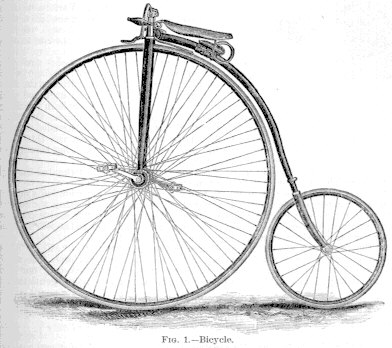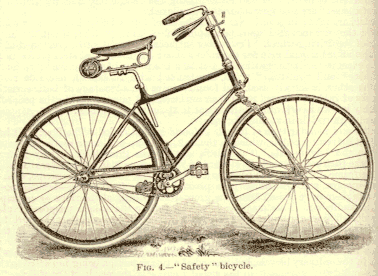The Bicycle
Today, let's talk about bicycles and freedom. The University of Houston's College of Engineering presents this series about the machines that make our civilization run, and the people whose ingenuity created them.
Let's talk about the technology of getting from place to place. After we've quit talking about steamboats, automobiles and airplanes, we find we've overlooked the one transportation medium that's touched all of our lives.
The history of the bicycle and that of the the horseless carriage mirror one another. Together they represent ways that the poor and the wealthy achieved freedom of motion. The early 19th century saw all kinds of new steam-powered vehicles. At first, steam carriages competed with locomotives, but railways won that battle because they made transportation inexpensive in a way steam carriages couldn't.
People wanted to be free to travel roads as they pleased. The new dream of rapid movement had to be individualized. If the answer wasn't the steam carriage, then maybe it could be the bicycle. Between 1816 and '18, Scottish, German, and French makers all came out with primitive bicycles.
Those early bikes seated a rider between a front and a back wheel with his feet touching the ground so he could propel himself with a walking motion. But that form of bicycle dates back to antiquity. We find images of them in renaissance stained glass, Pompeian frescoes -- even in Egyptian and Babylonian bas-reliefs.
Around 1839 another Scottish maker, Macmillan, added a feature when he built his hobbyhorse bicycle. It was a pedal-operated crank to drive the back wheel -- a lot like the pedal-operated chain drive on your bike. But the idea didn't catch on back then. It was 1866 before pedals appeared. Then it was on the front wheel, like the tricycles we rode as children.
Bicycles took off after the front-wheel pedal appeared. But there was a problem: The bigger the wheel, the further the bike would move on each turn of the pedal. That led to the dangerously unstable bicycle you've seen in so many Currier and Ives prints -- the one with the huge front wheel and the tiny back one. In its developed form, it was called the ordinary bicycle, but it was nicknamed "penny-farthing" because its wheels looked like large and small coins.
Not till 1885 did the tricky ordinary give way to the so-called safety bicycle. That's the technical name for the modern bike with two equal wheels, the back one driven by a chain and sprocket. The safety bike had a lot in common with MacMillan's hobbyhorse design from forty-six years earlier. It displaced the ordinary and became the basic bike design ever after.
So modern bikes entered the twentieth century along with the new gasoline automobiles. They freed people who couldn't afford cars. Now they too could go where they pleased. And, oh, the sense of freedom we felt as children when we got our first bikes! They let us fly like the wind and go where we wanted. They were wonderful things.
I'm John Lienhard, at the University of Houston, where we're interested in the way inventive minds work.
(Theme music)
This is a greatly revised version of Episode 78.
The story of the bicycle is told in many places. A very good account may be found in the Encyclopaedia Britannica.
Note added, July 9, 2015: The following site provides an excellent time-line of the bicycle from 1817 until 2012 -- until 13 years after this revised episode was written: http://www.icebike.org/58-milestones-from-bicycle-history-you-must-know/

"Penny-farthing" bicycle
From Appleton's Cyclopaedia of Applied Mechanics, 1892

Safety bicycle
From Appleton's Cyclopaedia of Applied Mechanics, 1892